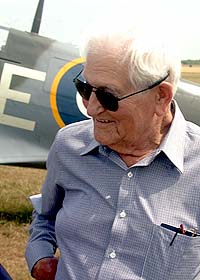Donald Blakeslee
| Donald James Matthew Blakeslee | |
|---|---|
 |
|
| Born |
September 11, 1917 Fairport Harbor, Ohio |
| Died | September 3, 2008 (aged 90) Miami, Florida |
| Allegiance | United States of America |
| Service/branch |
United States Air Force Royal Canadian Air Force |
| Years of service | 1941–1942 (RCAF) 1942–1965 (USAF) |
| Rank | Colonel |
| Unit |
No. 401 Squadron RCAF No. 133 (Eagle) Squadron RAF 335th Squadron of the 4th Fighter Group |
| Battles/wars |
World War II Korean War |
| Awards |
Distinguished Service Cross (2) Silver Star (2) Legion of Merit Distinguished Flying Cross (7) Air Medal (6) Distinguished Flying Cross (United Kingdom) |
Donald James Matthew Blakeslee (September 11, 1917 – September 3, 2008) was an officer in the United States Air Force, whose career began as a pilot in the Royal Canadian Air Force and flew Spitfire fighter aircraft, during World War II. He then became a member of the Royal Air Force Eagle squadrons. He flew more combat missions against the Luftwaffe than any other American fighter pilot.
Blakeslee was born in Fairport Harbor, Ohio on September 11, 1917 and became interested in flying after watching the Cleveland Air Races as a young boy. With money saved from his job with the Diamond Alkali Company, he and a friend purchased a Piper J-3 in the mid-1930s, flying it from Willoughby Field, Ohio. However, his friend crashed the plane in 1940, and Blakeslee decided the best way to remain flying was to join the RCAF.
After training in Canada, Blakeslee arrived in England on May 15, 1941, where he was assigned to No. 401 Squadron RCAF. The squadron was assigned to the Biggin Hill Wing. Flying sweeps over France, Pilot Officer Blakeslee seems to have first seen combat on November 18, 1941, when he damaged a Bf-109 near Le Touquet; and he claimed his first kill on November 22, 1941, a Bf-109 destroyed, over Desvres, about 10 miles south of Marck; on the same mission, he damaged a further Bf-109 whilst returning to base. His next kills were not claimed until April 28, 1942, two FW-190 probably destroyed. He proved to be not a particularly good shot, but was receptive to the principles involved in air fighting tactics, and was soon shown to be a gifted leader, in the air and on the ground.
...
Wikipedia
